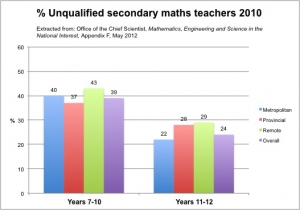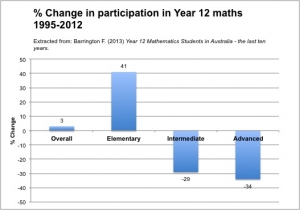PISA: A call to action for mathematics
The Australian Mathematical Sciences Institute (AMSI) calls on governments across Australia to act immediately to address the decline in mathematics. The results of the 2012 PISA international study, released yesterday, show that Australian 15 year olds have slipped to 17th place (from 13th in 2009) when it comes to mathematics. In absolute terms, Australian student performance has declined since PISA 2003 with the high performing end shrinking and the low performing end growing. These results indicate deep problems in school mathematics and there is every reason to believe that they started long before 2003.
This is an equity issue. It is no coincidence that the low SES schools, where the results are poorest, are the same schools where qualified maths teachers are hardest to find. There is an obvious link between the decline in results and decline in the number of trained secondary maths teachers. This is about teacher quality.
To be a qualified maths teacher generally requires two years of maths or stats in an undergraduate degree. According to Australia’s Chief Scientist, a student in years 7 to 10 in rural and remote regions across Australia has a 43% chance of being taught by a teacher without this, for city kids that figure is 40%.
“Governments have to face the fact that the content knowledge of those charged with teaching mathematics classes must be improved.” says Professor Geoff Prince, Director of AMSI. He continues “There is no pool of maths graduates out there waiting to become teachers in our secondary schools. We need to help the out-of-field teachers and we need to do it now. And we need to start attracting would-be teachers back into maths.”
Australian graduation rates in the mathematical sciences run at only half the OECD average for men and one-third for women. Why has the clear connection with the shortage of mathematics teachers not been sufficiently recognised by Australian governments?
This is not about which party funds education to a higher level. What is needed is a coherent, national program of enhancing teacher quality coupled with mathematically rigorous teacher resources for the new national curriculum. Over the 12 years PISA has been conducted we have had governments of all persuasions in the States, territories and federally. The state of mathematics comes down to return on investment: poor investment equals poor return. Australia is reaping now the fruits of 20 years of neglect of the school teaching cohort in mathematics. The declining numbers of students taking intermediate and advanced maths at Year 12 help explain why the stock of qualified maths teachers is shrinking and they make grim reading for future employers of engineers, maths, statistics, science and technology graduates.
PISA assesses the mathematical, scientific and English literacy of 15-year-old students in 65 countries and is conducted every 3 years. The purpose of the assessment is to find out about preparedness for the world outside of school for students are who are close to the end of their compulsory school years.
A random sample of 15-year-old students is drawn from a nationally representative sample of schools. In 2012 the PISA assessment involved about half-a-million students representing 28 million 15-year-olds. In Australia, 14 481 students from 775 schools took part. Students are assessed across three broad areas: Situations and contexts, Content areas and Competencies and Processes. Australia was ranked
- 17th on the formulating situations mathematically subscale
- 20th on the employing mathematical concepts, facts, procedures and reasoning subscale and
- 13th on the interpreting, applying and evaluating mathematical outcomes subscale.
Though the PISA report confirms that Australian students value mathematics at a rate higher than the OECD average, we still have one-third of 15 year-old females and one-fifth of 15 year-old males in Australia who report that mathematics was not important for later study. This age group is the source of a generation of Australia’s primary teachers. Shouldn’t these potential teachers value mathematics more highly?
Universities, employers, schools and governments should all be concerned about security of supply of mathematically capable graduates from our school and university system. If we want a truly equitable program of mathematics teaching and learning in Australia, something needs to be done to turn around the skills and attitudes of our future 15 and 16 year olds. AMSI believes this is best done through our teachers. Let’s set a high bar for the knowledge and skills that our teachers share with their students, for their future and ours.
[columns] [one_half] [/one_half]
[one_half]
[/one_half]
[one_half] [/one_half]
[/columns]
[/one_half]
[/columns]
[columns] [one_half]
For Interview:
Prof. Geoff Prince, AMSI Director
T: (03) 8344 1779
M: 0407 546 336
E: director@amsi.org.au
Ms Janine McIntosh, AMSI Schools Manager
T: (03) 8344 1790
M: 0402 408 507
E: janine@amsi.org.au
Media Contact:
Stéphanie Pradier
M: 0424 568 314
E: stephanie@amsi.org.au


